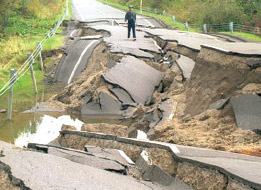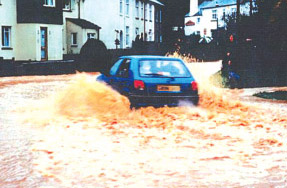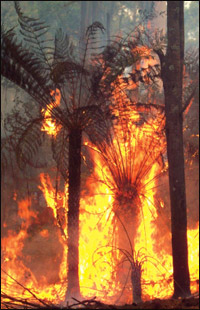|

Hardly a day goes by without the news of a natural disaster which has
affected some part of the world being reported. Going by the various
incidence taking place
  around
the world it certainly seems as if the numbers and the frequency in
which such natural disasters occur are increasing rapidly. Global
warming is definitely a major contributory factor for most of these
disasters. The changing weather conditions experienced in our country
alone are strong enough evidence as to the impact global warming has had
on climatic conditions everywhere. The torrential rain, strong winds and
lightning which are common during the Monsoon seasons seems to be
getting worse with each passing year, with the damage and death caused
by them too increasing. around
the world it certainly seems as if the numbers and the frequency in
which such natural disasters occur are increasing rapidly. Global
warming is definitely a major contributory factor for most of these
disasters. The changing weather conditions experienced in our country
alone are strong enough evidence as to the impact global warming has had
on climatic conditions everywhere. The torrential rain, strong winds and
lightning which are common during the Monsoon seasons seems to be
getting worse with each passing year, with the damage and death caused
by them too increasing.
Natural disasters are striking many parts of the world today and we
need to be more alert to the causes of such disasters and the dangers
that come along with them. We are responsible for what's happening all
around us. The chain reaction our careless acts have led to, is
incredible. When we pollute the environment, cut down trees and destroy
natural habitats, we little realise the harm we do to Mother Nature and
the ecological balance of the Earth. Every individual act may seem so
harmless when considered separately, but when taken collectively, the
impact is tremendous.
Global warming is increasing at dangerous levels making Planet Earth,
a ticking time bomb. It is not only the atmosphere and the surface that
gets hot but also the core of the Earth, leading to many natural
disasters. Perhaps the loud noises and the cracking of rocks in Maho has
everything to do with global warming. One geologist has not ruled out
the possibility of volcanic activity while another says that mercury
levels have risen inside the Earth in that area. There have been some
 reports
of cracks in the earth and also some buildings in various other parts
too from time to time. May be Mother Nature is angry and getting ready
to strike back.... reports
of cracks in the earth and also some buildings in various other parts
too from time to time. May be Mother Nature is angry and getting ready
to strike back....
What happens when Mother Nature unleashes her fury? Natural disasters
take place of course. You may be aware that natural disasters are all
natural hazards that affect the environment leading to economic and
human loss. They may be land, weather fire or water related or even
health and food related. Land related natural disasters include
earthquakes, avalanches, lahars and volcanic eruptions while weather
related disasters include tornadoes, blizzards, cyclonic storms,
droughts, hurricanes, mud slides and heatwaves. Water related disasters
are floods and of course tsunamis. Fire too leads to many disasters and
bush fires or wild fires are a major threat to life and property. And if
you are wondering what the health related natural disasters are, they
are the various diseases that spread causing epidemics where millions of
people contract the disease and eventually die. A food related disaster
is a famine which actually occurs following a severe drought.
Miru
*********
Deaths and chaos
Natural disasters are occurring frequently in many parts of the globe
today. Some of them are happening in countries which have had no such
incidents for ages. How lucky we in Sri Lanka are to be spared the
natural disasters some countries face. I was reminded of this fact, when
I read news items like these in the newspapers recently.
Death toll tops 145 in Brazil's
flooding
Flooding continues to paralise Rio
Quake rocks Mexico
Major quake hits Indonesia
These were news items in the first ten days of April. Then, there was
that horrible earthquake in Haiti, in the Caribbean Sea, in January that
flattened parts of the country's capital and left the President
homeless.

The biggest disaster we Sri Lankans faced in over 100 years was the
tsunami of 2004. We have had major floods, severe droughts for two to
three months strong gales and even a cyclone that did much damage in the
Eastern Province in 1978.
Except for the tsunami, these were minor disasters compared to the
continuous rain in Brazil and the quake in Haiti which killed more than
all the people killed by the tsunami in countries round the Indian
Ocean.
Here is what the newspapers reported about these natural disasters.
Details are given here so that you'll know the extent and the sort of
damage done. When we do not treat Mother Nature properly she unleashes
her fury.
Rains in Rio
Rains kept pouring down on Rio de Janeiro, Brazil's second largest
city and its neighbour across the bay, from late Monday morning, April
5. Residents and those going to work were stranded in flooded streets.
Some motorists abandoned their partly submerged cars and others were
stranded for hours inside stalled vehicles.
The rains continued for five days. Newspapers reported that this was
the heaviest rain in 48 years.
Part of a hillside on the other side of the bay collapsed into a
shanky town. Mud slides swept away shacks in Rio's hillside.Most people
died in mud slides. About 180 people worked throughout the night
searching for survivors under piles of mud covered rubble and twisted
metal.By the weekend the number of dead was estimated as 219 at least.
Earthquake hits Mexico
An earthquake struck Mexico at 3 pm on Sunday April 4. The quake was
so strong reading at 7.2 magnitude on the richter scale that homes were
rocked as far away as Los Angeles in the USA.
 In
Mexicali and other towns near the epicentre of the quake, walls and
roofs cracked, buildings collapsed or partly collapsed, but no deaths
were reported. Mexicali's water tank gave way. The hospital was partly
damaged and patients were being treated in tents. In
Mexicali and other towns near the epicentre of the quake, walls and
roofs cracked, buildings collapsed or partly collapsed, but no deaths
were reported. Mexicali's water tank gave way. The hospital was partly
damaged and patients were being treated in tents.
As the epicentre of the quake was in a rural farming area where few
people lived, the deaths were only two but 230 were injured. Farmers'
homes, schools and churches collapsed. Irrigation canals burst resulting
in extensive flooding.
The quake also pushed up water from underground making the area a
muddy mess. Many homes and schools were bogs. The landscape was like a
checker board with huge pools of water separated by dry patches. The
road connecting the villages to Mexicali could not be used because it
was torn apart in many places.
Panic in Indonesia
A powerful 7.8 magnitude earthquake hit the northern end of Sumatra
early Wednesday, April 7 causing widespread panic. Residents in the area
said they felt the Earth shudder for about a minute at around 5 pm. At
least five people were injured. There were tsunami warnings.
This was in Aceh Province, the areas devastated by the massive
tsunami of 2004.The Government issued a tsunami warning immediately but
it was lifted two hours later. Thailand also issued a tsunami warning
and asked the people in coastal areas to evacuate to a safe place as
there was a high risk of a tsunami on the Andaman coast. The warning was
cancelled later.
China cremates quake dead
While we in Sri Lanka were celebrating the New Year, on April 14, an
earthquake struck China's Qinghai province in the remote Tibetan
planteau. Jeigu town was shattered. The wood and mud huts fell down
killing or injuring the inmates. The brick and mortar buildings were
heavily damaged while some collapsed.
The official death toll was 1300. The injured numbered 11,000 of them
1200 seriously. On April 17 three days after the quake, more than 400
were missing.Hundreds of dead bodies were piled on massive funeral pyres
outside Jeigu town, and cremated by Bikkhus chanting religious stanzas.
More than 100 after shocks continued to rock the area and on Saturday
morning a quake with a magnitude of 5.1 was felt about 100 km from Jeigu
town.
Rescue workers were pulling dead bodies from underneath the rubble,
or bringing relief supplies to the injured. Another sad and unfortunate
thing happened. Many at least 200 trained rescue workers were forced to
leave because they were suffering from altitude sickness. The weather
was freezing cold and there was a lack of oxygen at that altitude
(height) of 400 metres.
Ash cloud over Europe
On the morning of April 14 a volcano erupted in South east Iceland
puffing out ash and smoke that went in waves mor than 6000 metres up in
the sky. Iceland is a few degrees west of the Greenwich Meridian, so
though this happened on 14 morning it was some hours after the quake in
China.
Massive ash clouds moving south and south east gradually spread
across Europe. On Friday more smoke spewed out of the volcano. By then
the ash cloud stretched from the Atlantic to Moscow (west-east) and
north-south from the Arctic to Bulgaria in south east Europe.The ash
cloud turned northern and western Europe into a no flying zone. Airports
in 18 countries in Europe were closed and flights cancelled. Thousands
of holiday makers, travellers on business, diplomats or missions were
stranded. Importers and exporters were hard hit. Even those holidaying
in Sri Lanka were stranded as some flights to Europe were cancelled.
By April 19 flights from Sri Lanka commenced. There were about 800
British nationals and about 500 German nationals stranded in Sri Lanka.
In addition there were other nationals.
-Sumana Saparamadu
Spewing ash....
The recent eruptions of Eyjafjallajökull, Icelandic for
"island-mountain glacier" over two- hundred years were the result of a
sequence of major volcanic activity. The volcano last erupted during the
last glacial period and most recently from 1821 to 1823 became active
again this year on March 20 and April 14.It started spewing ash again a
few days ago.
The glacier covers an area of about 100 square kilometres (39 sq mi).
The south end of the mountain was once part of the island's Atlantic
coastline, but over thousands of years the sea retreated some five
kilometres (3.1 mi), with the former coastline now consisting of sheer
cliffs with many waterfalls, of which the best known is Skógafoss. |

